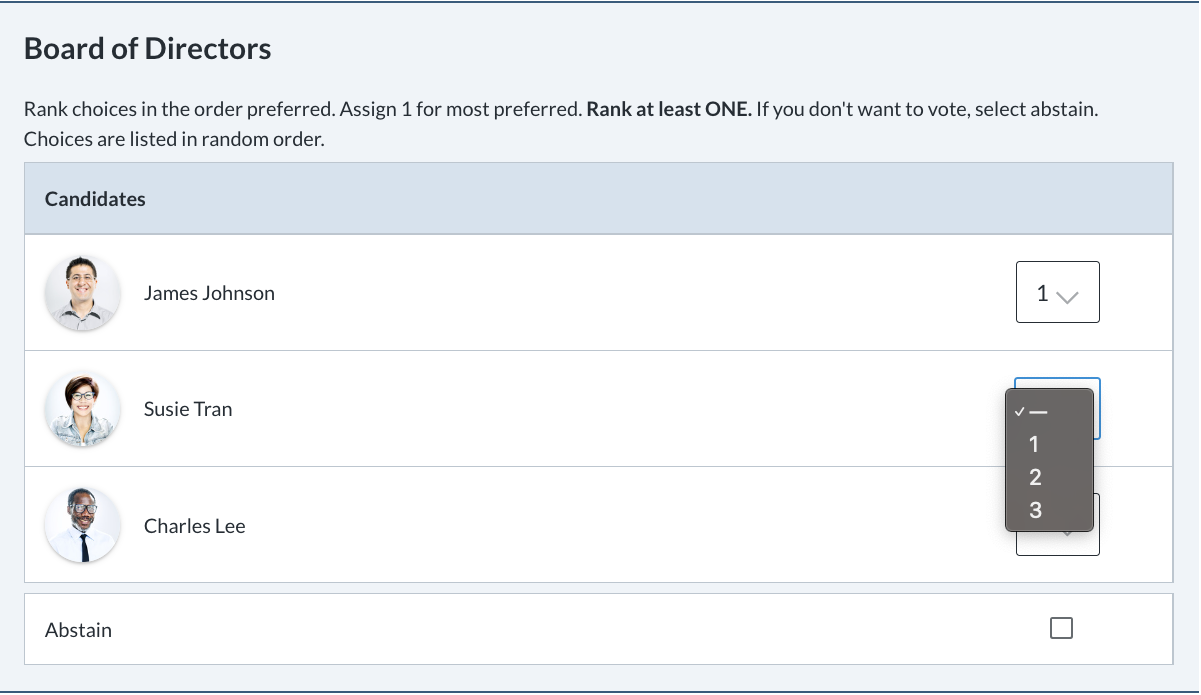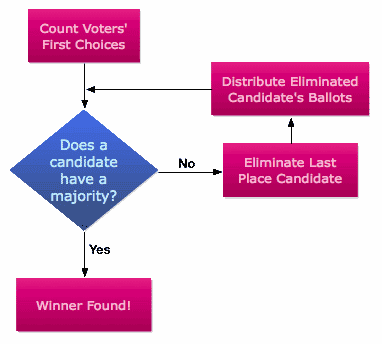Also known as Instant Runoff Voting

In a preferential voting election, voters rank the candidates in order of preference, with “1” being the highest (most preferred) ranking. For example, if there are 3 candidates, the voter chooses 1 beside their first choice, 2 beside their second choice, and 3 beside their third choice.
To be considered a valid ballot, the submitted ballot must satisfy the following conditions:
The first preference on each ballot counts as a vote for that particular candidate, and the votes are tallied. If no candidate receives a majority (greater than 50% of the total valid ballots), the candidate with the fewest number of votes is eliminated and the ballots for that candidate are redistributed to each ballot’s second preference. The process continues until a majority is reached by one of the candidates.

Note: There are many variants of winner selection that can also be done with this method, including Single Transferable Vote (STV). ElectionBuddy provides voting details while keeping voters anonymous so that you can select your own winner.
Preferential voting systems have become quite common in the United States, Australia, and Europe, especially in non-profit organizations, student organizations, and member-based groups. How preferential voting works is that it allows voters to select their preferred candidates on a ballot in the order of preference. For instance, if there are four candidates on the ballot, a voter will select their most preferred candidate as number one, their second preferred choice as number two, and so on, until all candidates have been assigned a number. This can be done via an online or software-based digital voting system.
One of the main purposes of this system is to ensure that the successful candidate achieves an absolute majority, over 50 percent of all the formal votes. This means that there can never be two candidates with the same number of votes. As the counting continues, the votes are redistributed between the candidates based on their preferential ranking until one candidate achieves the majority.
With the preferential system, there are no cases of gerrymandering because voters will choose the candidates on the ballot according to their preferences, giving each candidate an equal opportunity to participate in the election. Through this system, like-minded units get an opportunity to exchange their preferences and assist each other to win the election.
Full preferential voting means that voters must number all the boxes on the ballot in their order of preferences. However, voters are free to number the boxes on their ballots in any order they prefer. The most important thing is to ensure that all boxes are numbered properly to make the votes valid. If there are five candidates on the ballot, the boxes should be numbered with 1, 2, 3, 4, and 5. No two boxes should have the same number, and voters number their candidates accordingly based on their preference.
When there are only two candidates, selection becomes easy because the majority will support one of the candidates. But if there are more than two candidates, chances are that none of the candidates will achieve the majority support. This can be problematic, especially when the objective is to find out which candidate is preferred by most people.
In Australia, this electoral system became fully operational in a by-election in 1918 when a Labor candidate won on slightly over one-third of all the votes because the Conservatives were split between the Country and Nationalist parties. So, the majority of voters ended up with a minority member of parliament because they couldn’t support one party. The Labor candidate, Edwin Corboy garnered 6,540 votes while the Country and Nationalist candidates garnered 5,975 and 5,635 votes, respectively. Corboy was declared the winner because he had the majority of the formal votes.
Preferential voting and rank-choice voting have a lot of similarities, especially since both allow voters to rank different candidates in their order of preference. The two election systems require voters to rank their preferred candidates in a sequence of 1st, 2nd, 3rd, and so on. In American literature, rank-choice voting is considered part of the preferential system. In general, preferential voting encompasses different election systems that allow voters to rank candidates on the ballot.
In this election system, the winning candidate must achieve an absolute majority of the total number of formal votes. This means that the highly preferred candidate must get more than 50 percent of the total formal votes. The votes are allocated to each candidate based on how the voters have ranked them.
Once all the votes have been sorted, electoral officials will count the votes for each candidate. If no candidate gets the absolute majority, the officials will conduct a preference distribution by excluding the candidate with the least number of votes. Their votes are allocated to the next preferred candidate. Then, the total votes for the remaining candidates are counted. This redistribution exercise continues until one candidate gets the absolute majority and is declared the winner.
For further details, please visit Instant Runoff Voting on Wikipedia